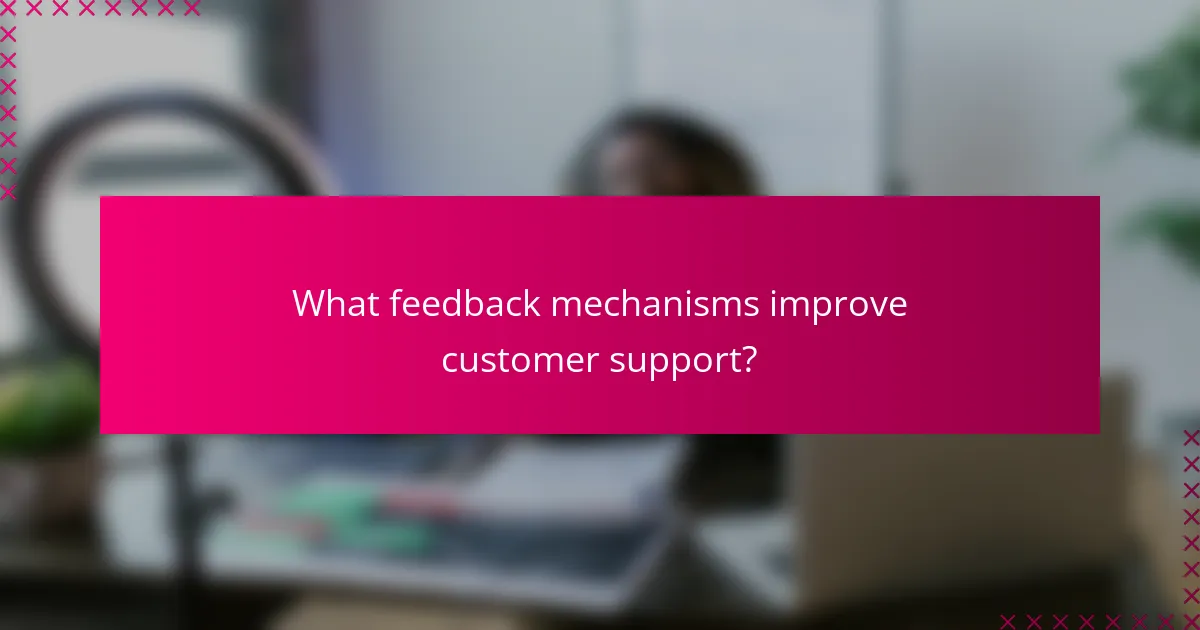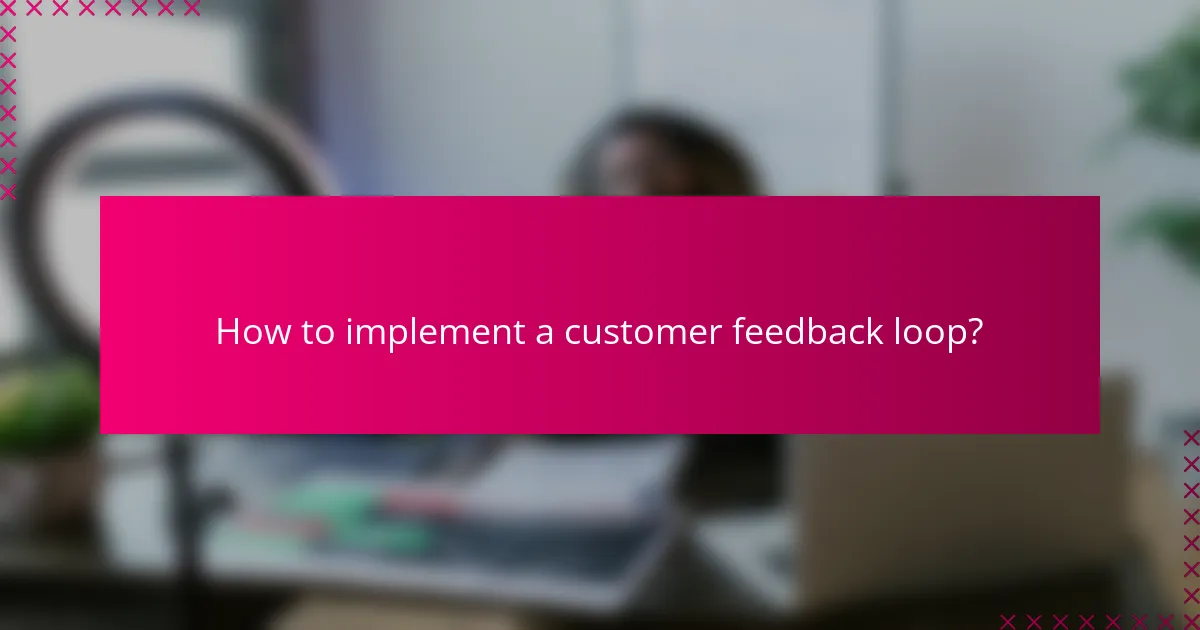Assessing customer support quality is crucial for understanding and improving customer experiences. By evaluating metrics such as response times, customer satisfaction scores, and ticket resolution rates, businesses can gain valuable insights into their support performance. Implementing effective feedback mechanisms further enhances service quality, enabling organizations to identify areas for improvement and increase overall customer satisfaction.

How to assess customer support quality in the UK?
Assessing customer support quality in the UK involves evaluating various metrics and feedback mechanisms that reflect customer experiences. Key criteria include customer satisfaction surveys, response times, and overall effort required from customers to resolve issues.
Customer satisfaction surveys
Customer satisfaction surveys are essential tools for gauging how well support teams meet customer needs. These surveys typically ask customers to rate their experience on a scale, providing insights into areas for improvement.
When designing surveys, focus on clear and concise questions that address specific aspects of the support experience, such as friendliness, efficiency, and issue resolution. Aim for a response rate of at least 20-30% to ensure meaningful data.
Net Promoter Score (NPS)
The Net Promoter Score (NPS) measures customer loyalty by asking how likely customers are to recommend your service to others. This single-question survey helps identify promoters, passives, and detractors, providing a clear picture of overall customer sentiment.
To calculate NPS, subtract the percentage of detractors from the percentage of promoters. A score above 50 is considered excellent, while anything below zero indicates significant issues that need addressing.
First response time metrics
First response time metrics track how quickly customer support teams respond to inquiries. This metric is crucial as it sets the tone for the customer’s experience and can significantly impact satisfaction levels.
In the UK, aim for a first response time of under 1 hour for email inquiries and under 5 minutes for live chat. Regularly monitor these times and adjust staffing or processes as needed to meet these benchmarks.
Resolution time analysis
Resolution time analysis measures the duration it takes to fully resolve customer issues. This metric is vital for understanding efficiency and effectiveness in customer support operations.
To improve resolution times, categorize issues by complexity and ensure that support staff have the necessary training and resources. Aiming for resolution within 24 hours for most inquiries can enhance customer satisfaction.
Customer effort score
The Customer Effort Score (CES) assesses how easy it is for customers to get their issues resolved. A lower effort score indicates a smoother experience, which is often linked to higher customer loyalty.
To measure CES, ask customers to rate the ease of their experience on a scale from 1 to 7. Strive for a score of 5 or higher, and focus on reducing friction points in the support process, such as simplifying contact methods and providing clear instructions.

What metrics are essential for evaluating support quality?
Essential metrics for evaluating support quality include response times, customer satisfaction scores, ticket resolution rates, and support channel effectiveness. These metrics provide a comprehensive view of how well customer support teams are performing and where improvements can be made.
Response time metrics
Response time metrics measure how quickly support teams acknowledge and respond to customer inquiries. This can include initial response times, which ideally should be within a few minutes for urgent issues, and overall time taken to resolve a ticket. Fast response times often correlate with higher customer satisfaction.
To effectively track response times, consider using automated tools that log timestamps for each interaction. Aim for benchmarks that align with industry standards, which typically suggest responding to 80% of inquiries within a specified time frame, such as 5 minutes for chat support.
Customer satisfaction score
The customer satisfaction score (CSAT) gauges how satisfied customers are with the support they received. This is usually measured through post-interaction surveys where customers rate their experience on a scale, often from 1 to 5 or 1 to 10. A higher CSAT indicates better service quality.
To improve CSAT, focus on training support staff to enhance their communication skills and product knowledge. Regularly review feedback to identify common pain points and address them proactively. Aiming for a CSAT score above 80% is generally considered a good target.
Ticket resolution rate
The ticket resolution rate measures the percentage of support requests that are successfully resolved within a given timeframe. A high resolution rate indicates that the support team is effective in addressing customer issues. Tracking this metric helps identify areas where additional training or resources may be needed.
To maintain a healthy resolution rate, ensure that support agents have access to adequate resources and knowledge bases. Aim for a resolution rate of at least 70-80%, and analyze unresolved tickets to understand the underlying causes and improve processes.
Support channel effectiveness
Support channel effectiveness evaluates how well different communication channels (such as phone, email, chat, and social media) perform in resolving customer issues. Each channel may have varying effectiveness based on customer preferences and the nature of the inquiries.
To assess channel effectiveness, track metrics like response times and resolution rates across each channel. Consider customer feedback to determine which channels are preferred and where improvements are needed. Strive for a balanced approach that meets customer needs while optimizing resource allocation across channels.

What feedback mechanisms improve customer support?
Effective feedback mechanisms enhance customer support by providing actionable insights into service quality. Utilizing various tools allows businesses to gather real-time data, identify areas for improvement, and ultimately boost customer satisfaction.
Post-interaction surveys
Post-interaction surveys are a direct way to gather customer feedback immediately after a support interaction. These surveys typically include questions about the customer’s experience, satisfaction levels, and suggestions for improvement.
To maximize response rates, keep surveys short, ideally under five questions, and consider offering incentives. Questions can range from rating the interaction on a scale to open-ended queries about what could be improved.
Live chat feedback tools
Live chat feedback tools allow customers to provide instant feedback during or after a chat session. These tools can prompt users to rate their experience or leave comments, providing immediate insights into service quality.
Implementing a simple thumbs-up or thumbs-down system can quickly gauge customer sentiment. Additionally, follow-up questions can help clarify the reasons behind their ratings, leading to more detailed feedback.
Social media monitoring
Social media monitoring involves tracking mentions of your brand across platforms like Twitter, Facebook, and Instagram to assess customer sentiment. This method captures unsolicited feedback, which can be invaluable for understanding public perception of your support services.
Utilize tools that aggregate social media mentions and analyze sentiment trends. Responding promptly to feedback on these platforms can enhance customer relations and demonstrate that you value their opinions.

How to implement a customer feedback loop?
Implementing a customer feedback loop involves systematically collecting, analyzing, and acting on customer insights to enhance service quality. This process ensures that customer voices are heard and integrated into business strategies for continuous improvement.
Regular feedback collection
Regular feedback collection is essential for maintaining a responsive customer support system. Utilize various channels such as surveys, social media, and direct communication to gather insights consistently. Aim to collect feedback after key interactions, ensuring that customers feel their opinions are valued.
Consider using a mix of quantitative and qualitative methods. For instance, short surveys with rating scales can provide measurable data, while open-ended questions allow for deeper insights. Schedule feedback collection at regular intervals, such as monthly or quarterly, to track changes over time.
Data analysis for trends
Data analysis is crucial for identifying trends in customer feedback. Use analytical tools to aggregate and interpret data, looking for patterns that indicate strengths and weaknesses in your support services. Focus on metrics such as customer satisfaction scores, response times, and issue resolution rates.
Visualize your data through charts or dashboards to make trends more accessible. Regularly review this information to stay informed about customer sentiment and adjust your strategies accordingly. This proactive approach helps in anticipating customer needs and improving overall service quality.
Action plans based on feedback
Creating action plans based on feedback ensures that insights lead to tangible improvements. Prioritize issues identified through customer feedback and develop targeted strategies to address them. For example, if customers frequently mention long wait times, consider increasing staff during peak hours or enhancing self-service options.
Involve your team in the action planning process to foster ownership and accountability. Set clear, measurable goals for improvement and establish timelines for implementation. Regularly revisit and adjust these plans based on ongoing feedback to ensure they remain effective and relevant.

What are the best practices for customer support in SaaS?
Best practices for customer support in SaaS focus on delivering timely, effective, and empathetic assistance to users. Implementing strategies that enhance user experience and satisfaction is crucial for retaining customers and fostering loyalty.
Proactive support strategies
Proactive support strategies involve anticipating customer needs and addressing potential issues before they arise. This can include monitoring user behavior to identify patterns that may indicate confusion or frustration, allowing support teams to reach out with solutions.
For example, sending automated messages to users who have not completed a key task can help guide them through the process. Regular check-ins with customers can also uncover potential problems early, leading to higher satisfaction rates.
Utilizing AI chatbots
AI chatbots can significantly enhance customer support by providing instant responses to common queries. These bots can handle a variety of tasks, from answering FAQs to guiding users through troubleshooting steps, all while being available 24/7.
When implementing chatbots, ensure they are well-trained with relevant data to provide accurate information. However, it’s essential to have a seamless transition to human agents for more complex issues, as this maintains a high level of customer service.
Training and development programs
Training and development programs for customer support teams are vital for maintaining high service quality. Regular training sessions can equip agents with the latest product knowledge and soft skills necessary for effective communication and problem-solving.
Consider implementing role-playing exercises and feedback loops to enhance agent performance. Investing in continuous education not only improves customer interactions but also boosts employee morale and retention, leading to a more experienced support team overall.

What tools can enhance customer support quality?
Various tools can significantly improve customer support quality by streamlining communication, tracking performance, and gathering feedback. Implementing the right technology can lead to faster response times and higher customer satisfaction.
Helpdesk Software
Helpdesk software centralizes customer inquiries, allowing support teams to manage tickets efficiently. This type of tool often includes features like automated responses, ticket prioritization, and reporting capabilities, which help in tracking performance metrics.
Popular helpdesk solutions include Zendesk, Freshdesk, and Help Scout. These platforms typically offer tiered pricing based on the number of agents and features required, making it easy for businesses of various sizes to find a suitable option.
Customer Relationship Management (CRM) Systems
CRM systems enhance customer support by providing a comprehensive view of customer interactions across different channels. This enables support agents to personalize their responses and resolve issues more effectively.
Tools like Salesforce and HubSpot CRM allow for integration with other support tools, ensuring that all customer data is accessible in one place. Investing in a CRM can lead to improved customer loyalty and retention.
Live Chat Tools
Live chat tools facilitate real-time communication between customers and support agents, which can significantly reduce response times. Many customers prefer live chat for its immediacy, making it a crucial component of modern customer support.
Examples of effective live chat solutions include Intercom and Drift. These tools often come with features like chatbots for initial inquiries, which can help filter questions and provide instant answers.
Feedback and Survey Tools
Feedback and survey tools are essential for assessing customer satisfaction and identifying areas for improvement. Regularly collecting feedback helps businesses understand customer needs and expectations.
Platforms like SurveyMonkey and Typeform allow for easy creation of surveys that can be sent post-interaction. Analyzing this feedback can guide training and operational adjustments to enhance overall service quality.
